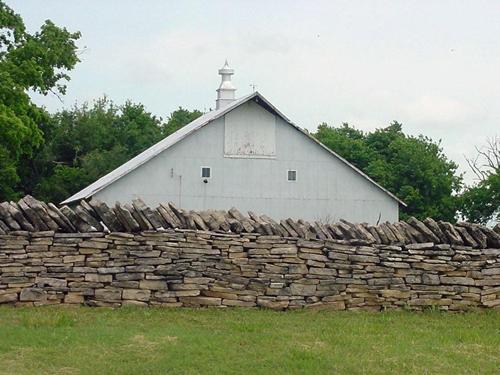|
|
From
Boerne to Burnet
and beyond, the Hill
Country is noted for its numerous rock fences, stock pens and
cemetery enclosures. You see them most often in counties settled by
German immigrants, but a more fundamental common denominator is the
availability of building material -- variably shaped rocks.
Far more lasting than wooden rail fences, this type of enclosure was
common before the advent of barbed
wire, though some of the were built as late as the early 1900s.
Most of them still stand more than a century-and-a-half after being
built. |
|
|
A
Hill Country rock fence
Photo courtesy Shannan Yarbrough, 2005 |
| |
Louis
Grosz, born in Hueffenhardt, Germany in 1853, came to Texas
when he was 18. His uncle, Phillipp Eckert of Mason
County, had written and told him what tools he needed to bring
to make a living in America. Grosz weighed his two trunks down with
iron, including a broad axe needed to build a log cabin.
As Estella Hartmann Orrison related in a family history she self-published
in 1957, “Eckert Record,” when Grosz finally reached the Hill
Country he had to go to work to repay the $50 his uncle had advanced
him for his passage to Texas. His first
income came from laying rock fences at 50 cents a day in an era when
no one had yet considered working only eight hours out of 24. |
Likely
toiling from “can see to can’t,” Grosz’ rate of compensation amounted
to only pennies on the hour. And the work must have been brutally
hard. Roy Bedichek, in his 1947 book “Adventures with a Texas Naturalist,”
estimated the stone fences on his place in Hays
County weighed “not less than a ton per linear yard.” The rule
of thumb passed down to the present is that it took one man one day
to build three feet of fence three feet high.
|
|
That three-feet-a-day
pace involved not only the relatively mindless toil of finding, digging
up, lifting and hauling suitable rocks but the more cerebral activity
of sorting and stacking them just so. Gravity held these fences together,
not mortar. The rocks had to fit snugly and be balanced.
Picture working a gigantic puzzle with very heavy pieces in a climate
where most of the time it’s too hot and sometimes too wet or cold
or both. Throw in a sore back and the occasional displaced scorpion
or rattlesnake and you have a pretty tough way to make four bits a
day. Oh, and hostile Indians still posed a danger in Mason
County when Grosz had to earn money as a rock fence builder.
While rock fences also are known as “German fences,” research by University
of Texas graduate Laura Knott, a landscape architect specializing
in historic preservation revealed that dry-laid fences did not originate
in Germany. Rather, the style used in Texas and elsewhere in the South
seems to have been modeled after rock fences common to Great Britain.
Knott theorized that German Texans learned of the style and imitated
it. On the other hand, it doesn’t take a rock-it scientist to figure
that a potential farm field strewn with plow-breaking stones could
be both fenced and cleared by stacking those very stones. |
 |
A rock wall in
Kansas
TE photo, 2005 |
|
No
matter their origin, rock fences are of two varieties: Single thickness
walls about one foot wide and double-sided structures. Those two-siders,
obviously, stood the stoutest.
In building the thicker fences, a rock-stacking artisan put up one
wall and then another parallel to it, leaving enough room in between
for a fill of smaller stones called “hearting.” The builder connected
the two walls with long, flat stones known as “throughs.”
In the course of her university research, Knott found a Blanco County
farmer named John Cox (no relation to the author) who learned both
fence-building and some philosophy from his father.
“I remember
a day that he was building fences and I was learning,” Knott quoted
Cox. “‘Rocks must fit as close as words,’ he said as he put a rock
in place….He never put a stone where it didn’t want to stay. ‘Work
with nature, not against it…if you want a fence to stand.’”
As for Grosz, after repaying his relative by laboring at fence building,
he moved on to easier ways of making money like blacksmithing, furniture
building, stone cutting and farming. In between, he and his wife
raised 11 children.
Though Grosz could do many things, he must have been pretty handy
at the work that paid for his immigration. He continued to hire
out periodically as a fence builder. When his sons had grown strong
enough, he put them to work hauling rocks while he did the stacking
that required more experience. He continued to build stone fences
even after wire made them obsolete.
Like railroad workers laying track, the Grosz’ stayed in the field
until they finished a job, moving their camp site as their enduring
handiwork slowed progressed across a field. Twice a week, Grosz
would send his boys home to fetch more grub while he stayed in camp
near the fence in progress.
A relapse of measles, not hard work, killed Grosz at the age of
45 in the spring of 1899. They buried him in the Gooch Cemetery
on the eastern edge of Mason.
Most, if not all, of his rock fences still stand.
© Mike Cox
"Texas Tales"
February 7 , 2008 column
|
|
|
